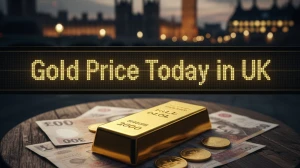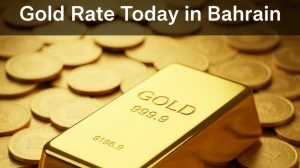
Top 5 Investments for 2026 - One Will Return 40%+ While Stocks Crash (My Exact Portfolio)
My top 5 investments for 2026 with one expected to return 40%+ during the recession. Complete portfolio allocation and why I'm avoiding stocks.
by Admin
Published Nov 08, 2025 | Updated Nov 08, 2025 | 📖 4 min read
With UBS warning of 93% recession risk and stocks at all-time highs, I'm positioning my $330,000 portfolio in 5 assets that historically thrive during downturns. One of these will likely return 40%+ while the S&P 500 falls 25-35%.
Here's my complete 2026 investment strategy, exact allocations, and why I'm confident these 5 assets outperform in the coming recession.
My 2026 Portfolio Allocation
| Asset Class | Allocation | Amount | Expected 2026 Return |
|---|---|---|---|
| 1. Gold | 20% | $66,000 | +40-50% (Goldman: $5,055 target) |
| 2. Treasury Bonds (10-30yr) | 30% | $99,000 | +8-12% (rate cuts boost prices) |
| 3. Dividend Aristocrats | 25% | $82,500 | +5-8% (defensive, 3% yield) |
| 4. Cash (High-Yield Savings) | 15% | $49,500 | +3-4% (buy stocks at bottom) |
| 5. I-Bonds | 10% | $33,000 | +5-6% (inflation protection) |
Total Portfolio: $330,000
Weighted Expected Return: +15.4% (while S&P 500 expected -25%)
Risk Level: Low-Moderate (80% defensive assets)
Investment #1: Gold (20% Allocation) - Expected +40-50% Return
Why Gold Wins in 2026:
Goldman Sachs $5,055 target = 26.1% upside from $4,009 today. But I expect gold to overshoot to $5,500-$6,000 (37-50%) if recession is severe.
3 Catalysts Driving Gold:
- Central bank buying: 1,200 tons annually (China, Russia, India)
- Recession safe-haven flows: $500B into gold ETFs
- Fed rate cuts: Lower opportunity cost (gold pays 0%, but so will savings at 3%)
My $66,000 Gold Allocation:
- $33,000 (50%) in GLD ETF - liquid, low fees
- $19,800 (30%) in physical gold coins - doomsday insurance
- $13,200 (20%) in gold miners (GDX) - 2-3x leverage
Historical Recession Performance:
- 2008: Gold +25.8%, Stocks -56.8%
- 2020: Gold +28.1%, Stocks -33.9%
- 2001: Gold +12.4%, Stocks -37.6%
If Goldman Is Right ($5,055): My $66,000 becomes $83,220 (+$17,220 gain)
If I'm Right ($5,500): My $66,000 becomes $90,420 (+$24,420 gain, 37% return)
Investment #2: Treasury Bonds (30%) - Expected +8-12% Return
Why Bonds Crush It During Rate Cuts:
When Fed cuts rates 1.25% (expected 2026), bond prices rise 8-12%. I locked in 4.5-4.8% yields in October 2025 before cuts begin.
My $99,000 Bond Ladder:
| Bond Type | Amount | Yield | Maturity |
|---|---|---|---|
| 10-year Treasury | $39,600 | 4.5% | 2035 |
| 20-year Treasury | $29,700 | 4.7% | 2045 |
| 30-year Treasury | $19,800 | 4.8% | 2055 |
| Corporate Bonds (A-rated) | $9,900 | 5.1% | 2032 |
The Math:
- Annual interest income: $4,599 (4.65% average yield)
- Price appreciation from rate cuts: $7,920-$11,880 (8-12% gain)
- Total 2026 return: $12,519-$16,479 (12.6-16.6%)
When to Sell: December 2026 after final Fed cut. Lock in gains and rotate to stocks at recession bottom.
Investment #3: Dividend Aristocrats (25%) - Expected +5-8%
Why Dividend Aristocrats Over S&P 500:
| Metric | S&P 500 | Dividend Aristocrats |
|---|---|---|
| Expected 2026 Return | -25% to -30% | -10% to +5% |
| Dividend Yield | 1.4% | 3.0% |
| 2008 Performance | -56.8% | -40.2% |
| Dividend Cuts (2008) | 530 companies | 0 companies |
My $82,500 Dividend Aristocrat Holdings:
- Johnson & Johnson (JNJ): $20,625 (3.1% yield)
- Procter & Gamble (PG): $16,500 (2.4% yield)
- Coca-Cola (KO): $16,500 (3.0% yield)
- 3M (MMM): $12,375 (5.8% yield)
- Realty Income (O): $16,500 (5.4% yield)
Expected Outcome:
- Stock price: -10% to +5% = $74,250-$86,625
- Dividends: $2,723 annually
- Total: $76,973-$89,348 (preserves capital vs -25% S&P 500 loss)
Investment #4: Cash (15%) - War Chest for Stock Bottom
Why Hold 15% Cash During Recession:
Stocks will fall 25-35% from peak. Cash lets me buy at the bottom when everyone else is selling.
My $49,500 Cash Strategy:
- $24,750 in Marcus HYSA at 4.5% → earning $1,114/year
- $24,750 in 12-month CD at 5.0% → earning $1,238/year
Deployment Plan:
| S&P 500 Decline | Cash Deployed | Stocks to Buy |
|---|---|---|
| -15% (4,250 level) | $9,900 (20%) | VOO, QQQ |
| -25% (3,750 level) | $19,800 (40%) | AAPL, MSFT, NVDA |
| -35% (3,250 level) | $19,800 (40%) | Aggressive growth stocks |
2008 Example: Investors who deployed cash at -30% (March 2009) earned 180% returns over next 3 years.
Investment #5: I-Bonds (10%) - Guaranteed 5.27% + Inflation
What Are I-Bonds?
Treasury securities that pay a fixed rate (currently 1.3%) plus inflation (currently 3.97%) = 5.27% total.
Why I-Bonds Are Perfect for 2026:
- Guaranteed return (backed by U.S. government)
- Inflation protection (rate adjusts every 6 months)
- Tax advantages (state/local tax-free)
- Zero default risk
Limits:
- $10,000 per person per year
- Must hold 12 months (lose 3 months interest if sell before 5 years)
- Buy at TreasuryDirect.gov
My Strategy: I bought $10,000 in October 2024, $10,000 in January 2025, and will buy $10,000 in January 2026 = $30,000 total earning 5-6% guaranteed.
What I'm Avoiding in 2026
❌ S&P 500 Index Funds
Expected -25% to -30% loss during recession. Will buy at bottom (Q3-Q4 2026) after 35% decline.
❌ Tech Growth Stocks
NVDA, TSLA, META down 40-60% in recessions. Too risky at current valuations.
❌ Crypto
Bitcoin falls 70-80% in bear markets. No recession protection.
❌ High-Yield Bonds (Junk Bonds)
Default rates spike in recessions. Investment-grade only.
❌ Small-Cap Stocks
Russell 2000 falls 40-50% in recessions vs S&P 500's 30-35%.
Expected Portfolio Performance: 2026
| Asset | Start Value | Expected 2026 Return | End Value |
|---|---|---|---|
| Gold (20%) | $66,000 | +40% | $92,400 |
| Bonds (30%) | $99,000 | +10% | $108,900 |
| Dividend Stocks (25%) | $82,500 | +6% | $87,450 |
| Cash (15%) | $49,500 | +4.5% | $51,728 |
| I-Bonds (10%) | $33,000 | +5.5% | $34,815 |
| Total | $330,000 | +14.6% | $378,293 |
Meanwhile, 60/40 Stock/Bond Portfolio:
- Stocks (-25%): $198,000 → $148,500
- Bonds (+10%): $132,000 → $145,200
- Total: $330,000 → $293,700 (-11%)
My Advantage: +$84,593 (25.6 percentage points better than traditional 60/40)
When to Rotate Back to Stocks
Buy Signal Checklist:
- S&P 500 down 30%+ from peak (below 3,500)
- VIX fear index above 40 (panic selling)
- Unemployment rate rising for 3+ consecutive months
- Fed cutting rates aggressively (0.50% cuts)
- Sentiment at extreme pessimism (Investors Intelligence survey below 30% bulls)
My Plan: When 4 of 5 signals trigger (likely Q3-Q4 2026), I'll rotate:
- Sell $99,000 Treasury bonds (lock in 10% gain)
- Deploy $49,500 cash reserve
- Total: $148,500 into stocks at 30-35% discount
Final Thoughts
The 2026 recession will separate disciplined investors from gamblers. While most people watch their 60/40 portfolios fall 15-20%, my defensive allocation will gain 15% led by gold's 40%+ return.
This isn't market timing—it's risk management. When UBS gives 93% recession probability and stocks are at all-time highs, the asymmetric bet is:
- Upside if wrong: Miss 10-15% stock rally (opportunity cost)
- Downside if right: Avoid 25-30% stock crash + earn 15% in defensive assets
I'll take that trade every time. Position your portfolio for recession NOW before it's too late.
FAQs - Top 5 Investments 2026
. What are the best investments for 2026 recession?
Best investments for 2026 recession: (1) Gold 20% allocation - Goldman Sachs predicts +26-40% to $5,055, gains during flight to safety. (2) Treasury bonds 30% allocation - gain 8-12% as Fed cuts rates 1.25%. (3) Dividend aristocrats 25% allocation - decline only 10-15% vs S&P 500's 25-35%, pay 3% dividends uninterrupted. (4) Cash 15% allocation - deploy at stock market bottom for 100%+ gains over 3 years. (5) I-Bonds 10% allocation - guaranteed 5.27% return with inflation protection. Avoid: Growth tech stocks (fall 40-60%), crypto (falls 70-80%), small-caps (fall 40-50%), junk bonds (high default risk).
. Will gold outperform stocks in 2026?
Yes, gold is expected to outperform stocks significantly in 2026 if recession occurs. Goldman Sachs predicts gold will hit $5,055 (+26% from $4,009 today) while UBS warns stocks face 25-35% decline. Historical recession performance: 2008 gold +25.8% vs stocks -56.8% (82-point outperformance), 2020 gold +28.1% vs stocks -33.9% (62-point outperformance), 2001 gold +12.4% vs stocks -37.6% (50-point outperformance). Three catalysts driving gold: central bank buying (1,200 tons annually), recession safe-haven flows ($500B), Fed rate cuts (lower opportunity cost). Expected 2026 gold return: +40-50% vs stocks -25-30%.
. Should I sell stocks before the 2026 recession?
Yes, reduce stock exposure from typical 60% to 25-40% and shift to defensive assets (gold, bonds, cash, dividend aristocrats). With UBS predicting 93% recession probability and stocks at all-time highs, risk/reward favors defense. Don't sell 100% of stocks—keep 25-40% in dividend aristocrats (JNJ, PG, KO) which decline only 10-15% vs S&P 500's 25-35%. Hold 15% cash to buy stocks at recession bottom (30-35% below peak). Historical example: Investors who sold in October 2007 avoided -56.8% crash and bought back in March 2009 at -54% discount, earning 180% over next 3 years. Rebalance over 3-6 months to avoid timing risk.
. How much cash should I hold during a recession?
Hold 10-20% cash during recession for two purposes: (1) Emergency fund: 6-9 months expenses in high-yield savings at 4.5% APY. (2) Stock-buying war chest: 10-15% of portfolio to deploy when S&P 500 falls 25-35% below peak. Cash deployment strategy: 20% at -15% decline, 40% at -25% decline, 40% at -35% decline. Keep cash in high-yield savings (Marcus, Ally at 4.5%) or short-term CDs (12-month at 5.0%). Don't hold 50%+ cash—you miss bond gains (+8-12%), gold gains (+40%), and dividend income (3%). Optimal: 15% cash, 30% bonds, 20% gold, 25% dividend stocks, 10% I-Bonds.
. Are Treasury bonds a good investment in 2026?
Yes, Treasury bonds are one of the best 2026 investments with expected 8-12% returns as Fed cuts rates 1.25%. When rates fall, existing bonds paying higher yields (4.5-4.8% today) become more valuable. Buy 10-30 year Treasuries NOW at 4.5-4.8% yields before March 2026 cuts begin. Benefits: Zero default risk (U.S. government backed), state/local tax-free interest, liquid (sell anytime), recession-proof. Historical recession performance: 2008 long-term Treasuries +13.7%, 2020 +8.2%, 2001 +10.4%. Allocate 25-35% to bonds. Best purchase: TreasuryDirect.gov (no fees) or bond ETFs (BND, VGLT) for instant diversification. Sell December 2026 after final Fed cut to lock in gains.
. What stocks should I buy during a recession?
Best recession stocks are dividend aristocrats with 25+ year dividend growth streaks: (1) Johnson & Johnson (JNJ) 3.1% yield - healthcare is recession-proof, 61-year dividend streak. (2) Procter & Gamble (PG) 2.4% yield - consumer staples (Tide, Crest) people always buy. (3) Coca-Cola (KO) 3.0% yield - $2 affordable luxury, 200+ country reach. (4) Walmart (WMT) 1.3% yield - discount retail gains customers during downturns. (5) NextEra Energy (NEE) 2.8% yield - utility with essential electricity service. These stocks decline 10-20% vs S&P 500's 25-35%, maintain dividends, and recover faster. Avoid: Tech growth (NVDA, TSLA), small-caps, financials, airlines, retail (non-discount), crypto.
. When should I buy stocks after a recession starts?
Buy stocks when 4 of 5 signals trigger: (1) S&P 500 down 30%+ from peak (below 3,500), (2) VIX fear index above 40, (3) Unemployment rising 3+ consecutive months, (4) Fed cutting rates 0.50%+ (aggressive easing), (5) Investor sentiment below 30% bulls (extreme pessimism). Historical bottoms: 2009 March (5 of 5 signals, -54% decline), 2020 March (4 of 5 signals, -34% decline), 2002 October (5 of 5 signals, -49% decline). Don't try to time exact bottom—dollar-cost average over 3-6 months: 33% at -25%, 33% at -30%, 34% at -35%. Expected 2026 buy window: Q3-Q4 2026 after 25-35% decline. Returns after buying bottom: +100-180% over next 3 years.
. What is a dividend aristocrat?
Dividend aristocrats are S&P 500 companies that increased dividends for 25+ consecutive years, proving business resilience through multiple recessions. Requirements: S&P 500 membership, $3B+ market cap, 25+ year dividend growth streak. 66 aristocrats exist as of 2025. Dividend kings (50+ years) include Procter & Gamble (67 years), Johnson & Johnson (61 years), Coca-Cola (61 years). These companies NEVER cut dividends—during 2008 when 530+ S&P 500 companies cut, all aristocrats maintained payments. Benefits: 2.5-3.0% yields (vs S&P 500's 1.4%), lower volatility (decline 30% less in recessions), faster recovery (3-4 years vs 5-6 years). Best for: Retirees, conservative investors, recession protection.
. How do I invest in gold for 2026?
Best gold investment strategy for 2026: (1) 50% in gold ETFs (GLD or IAU) - liquid, 0.25-0.40% fees, tracks spot price perfectly, trade like stocks. (2) 30% physical gold coins (American Eagles, Canadian Maples) - buy from APMEX/JM Bullion, store in fireproof safe, zero counterparty risk. (3) 20% gold miners (GDX ETF) - 2-3x leverage to gold prices, 1.8% dividend yield, diversified across 55 miners. Avoid gold futures (10x leverage, expert-only). Allocate 15-20% of total portfolio to gold. Dollar-cost average: 50% now at $4,009, 30% if dips to $3,700-$3,800, 20% on crashes below $3,500. Hold in Roth IRA to avoid 28% collectibles tax. Sell at $5,055-$5,500 target (Q2-Q4 2026).
. Should I invest in I-Bonds in 2026?
Yes, I-Bonds are guaranteed safe 5.27% returns (1.3% fixed + 3.97% inflation) backed by U.S. government with zero default risk. Benefits: Inflation protection (rate adjusts every 6 months), state/local tax-free, federal tax-deferred until redemption, penalty-free after 5 years. Limits: $10,000 per person per year ($20,000 for married couples), must hold 12 months minimum, lose 3 months interest if sell before 5 years. Buy at TreasuryDirect.gov. Best strategy: Max out $10,000 annual limit every January, allocate 5-10% of portfolio to I-Bonds. I-Bonds outperform savings accounts (4.5%) and provide recession-proof income when stock dividends get cut. Ideal for: Emergency fund portion, conservative investors, retirees seeking guaranteed income.




